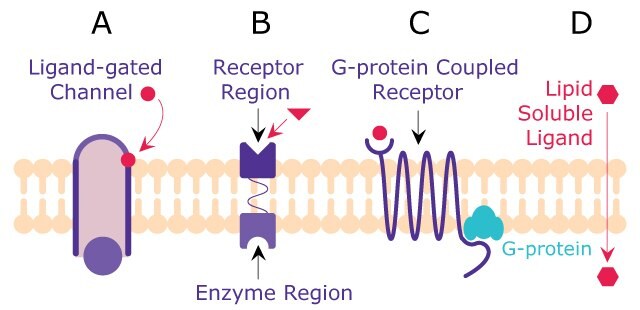Receptor Interactions
To understand the biological and clinical role of agonists and antagonists, it is important to think about the role of receptors in cellular function. Read on to explore different kinds of receptor interactions, including receptor-ligand interactions and drug-receptor interactions.
Read more about
What Are Receptors?
Receptors are regulatory proteins embedded in the plasma membrane, cytoplasm, or on the nuclear surface. The lock-and-key concept of enzyme inhibitors can also be applied to receptors, where certain molecules specifically bind to these receptors. As the name “receptor” implies, they are the recipients of signals that elicit a biological response. These signals may be hormones, selected amino acids, neurotransmitters, toxins, or pharmaceutical agents.
Receptor-Ligand Interactions
The distribution of receptors can be cell-specific, and each cell can have hundreds of different receptors, many of which can be involved in receptor-ligand interactions. When a ligand molecule (or an agonist) binds to a receptor, it changes the conformation of the receptor molecule and leads to a specific biological response.
Just as enzyme inhibitors can reduce enzyme activity, similarly, certain drugs can block the access of a ligand or agonist to the receptor site and diminish the biological response.
Drug Receptors
Although a drug receptor concept was postulated in the early 1900s, solid empirical evidence and subsequent adoption of receptor-mediated drug interactions did not gain wide acceptance until the 1950s. 1 Since that time, multiple models have been proposed to explain the interaction between ligand and receptor, with extended ternary complex models, which also include resulting molecular changes, such as G-protein interactions. 2
Researchers have described four basic mechanisms of transmembrane signaling (Figure 1). Each of these mechanisms uses a different strategy to overcome the barrier imposed by a plasma membrane. These mechanisms include:
- Use of ligand-gated channels, which open following ligand binding
- Use of transmembrane receptor proteins with “built-in” enzyme activity
- Use of transmembrane receptor proteins to stimulate GTP-binding proteins to relay signaling messages
- Use of a lipid-soluble ligand that can easily traverse the membrane

Figure 1.Four common transmembrane signaling mechanisms using A. ligand-gated channels, B. transmembrane receptor proteins with “built-in” enzyme activity, C. transmembrane receptor proteins that stimulate GTP-binding proteins, and D. lipid-soluble ligands.
Drug-Receptor Interactions
Most drug receptors are regulatory proteins with drug-receptor interactions that exhibit specific modulatory effects, which make them effective therapeutic targets. For example, in the simplest model as shown below, a small molecule agonist (A) binds to a receptor (R) with a fairly simple protein binding equilibrium (Ka). This ligand-receptor binding initiates a G-protein engagement (ARG complex), which leads to downstream cascade events.

Extended models, such as various Ternary Complex Models (Figure 2), account for more, complex factors, such as spontaneous isomerization of G-protein coupled receptor (R*), the affinity of the receptor for G protein, the presence of an agonist or antagonist, and inactive ARG complexes (Ka, Kg). More information on these models can be obtained from publications by Limbird (2004) and Christopoulos and Kenakin (2002) or from a suitable pharmacology textbook. 1,3

Figure 2.An example of a Ternary Complex Model.
Explore more receptor-ligand interactions in our Receptor Agonists and Antagonists article.
References
如要继续阅读,请登录或创建帐户。
暂无帐户?